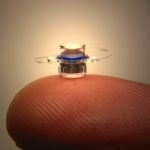Tiny Eye Implant – Returns Sight and Quality Life
 Telescope Implant for End-Stage AMD Approved for Adults 65+
Telescope Implant for End-Stage AMD Approved for Adults 65+
Age related macular degeneration (AMD) is the number one cause of severe vision loss and legal blindness in adults over 60 in the U.S. It is estimated that over 2 million Americans are living with end-stage AMD and that number will increase as the Boomer cohort ages. As it progresses, AMD blurs or completely blocks the sharp, central vision needed for activities such as reading, sewing, seeing faces and driving.
Despite treatment for AMD vastly improving over the past ten years, end-stage AMD is uncorrectable by any other treatment including glasses, vitamins, drugs or cataract surgery and is associated with increased stress and depression as vision diminishes.
This October, the U.S. Food and Drug Administration approved the telescope implant for use in patients living with end-stage AMD who are 65 years and older. The telescope implant is the only FDA approved surgical treatment for end-stage AMD. Smaller than a pea, the device is proven to improve vision and quality of life for patients whose central vision is permanently blocked by a blind spot caused by AMD.
Older adults who progress to end-stage AMD lose their ability to see moments in their lives and experience a reduction in their independence. Schenectady, NY resident and caregiver Linda, 55, helped her mother, Patty, 77, regain her vision and improve her quality of life when she learned about the telescope implant. Linda guided her mother through the evaluation and surgery process and then supported her during the rehabilitation, travelling with her to the occupational therapy and helping her mom with the prescribed exercises. Today, Patty’s improved vision allows her to live alone in the home where she raised her family. She can also cook on her gas stove, see who’s ringing her doorbell, watch TV and, most importantly, see the faces of her loved ones.
The telescope implant is the integral component of a program called CentraSight®, which helps patients follow the steps necessary for proper diagnosis, surgical evaluation, implantation and postoperative care. The device is placed in one eye and restores vision by magnifying images seen using straight-ahead vision and beaming them to undamaged sections of the macula, thereby effectively reducing the blind spot. The other eye is left “as is” to preserve peripheral vision, which is lost in the operated eye. Post-operatively, patients work with visual rehabilitation specialists to understand their new vision. Not everyone is a candidate for the telescope implant.
Potential patients must:
- Have irreversible, End-Stage AMD resulting from either dry or wet AMD
- Are no longer a candidate for drug treatment of AMD
- Have not had cataract surgery in the eye in which the telescope will be implanted
- Meet age, vision, and cornea health requirements
This procedure is available from over 100 physician teams across the country. It is also a Medicare eligible procedure. You or someone you love can learn more about the telescope implant by speaking with a clinical specialist available toll free at 877-99-SIGHT. Additional information is available at www.CentraSight.com.
Tiny Eye Implant – Returns Sight and Quality Life
Category: Senior Health



































